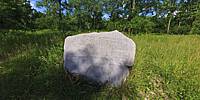
The Footsteps of Einstein and Fermi
Red Gate Woods, Cook County, Illinios, USA
June, 26, 2010, 3:00 pm
© 2010 Richard C. Drew, All Rights Reserved.
The birth of the first Nuclear Reactor begins with the ultra top-secret WW II Manhattan Project (that eventually produced the Atom Bomb) and should have ended with the reactors interment. But there were more chapters to that story...
You've constructed the first man-made nuclear reactor and helped launch the Nuclear Age. It's years later and you need to dispose of this pesky reactor (everything but the core.) You can't dump it in the lake with the trash. Nobody really has any idea how long this thing's going to provide free X-rays - but everyone involved knows it could be incredibly dangerous and toxic.
What to do, what to do? Why, bury it in a public forest preserve! To be fair, it was still the outskirts the original Argonne National Laboratory at that time. It became a public forest preserve much later. But still, that's what they did. Buried it. Twice, including the clean-up.
However, the Earth did not want the contaminated debris (or in Government speak, "Decommissioned Reactor" fragments) any more than the bureaucrats did. Over time the ground started heaving out possibly radioactive materials. The three-inch-thick concrete cap provided little protection. Irradiated chunks of concrete, steel and more were discovered on the surface a couple of decades later. Post chain-reaction bits and pieces littered the forest floor and were found alongside prairie grasses and wildflowers.
Some say there was little actually found on the surface – it was just the concrete cap breaking up, others contend that a few people panicked and exaggerated the actual problem, and others liken it to a debris strewn field. I'm sure the truth is in the middle somewhere.
Whatever the facts, the area was declared one of the most toxic places in the United States, and designated an EPA "superfund" clean-up site. The surrounding woods were closed. Few local residents were aware of this at the time.
The site was cleaned, topsoil replaced, the reactor parts re-buried, and everything concreted over again. With much thicker concrete and a lot more earth. Permanent sampling stations were installed, and a new marker placed.
The area re-opened, and the public could once again enjoy the woods. Some naysayers still consider the site dangerous, but the experts say it's safe, although digging is prohibited, and drinking water from the immediate area's many lakes and streams is not recommended. But then again, who would want to drink it even without the places history? We're not talking mountain streams or glacier melt – it's scummy, stagnant water. Just look at an aerial photo.
The site is constantly monitored and tested by the EPA.
It's also the only spot in the world where the public can get this close to a decommissioned nuclear reactor. It's near public bike paths, jogging and hiking trails. Few people know the area's history, or (cue dramatic music) What Lies Beneath...
There are two separate sections here – the burial site of the debris, and the site of the rebuilt reactor. Originally I was going to use the disposal site for the image, but decided on the reactor site instead. It's more historic, and is on the original grounds of the lab/research facility. The text on the monument is also more fascinating.
This is also the same ground where Albert Einstein and Enrico Fermi trod, and is on every science geek's list of "Places To Visit."
This is a historic location, and one that should be seen if the opportunity presents itself. Very few visitors to the forest preserve know the historic significance of these woods, or the part they played in world history.
I shot panos at both markers and have those and some HDR shots on my website.
From the WikiPedia:
Chicago Pile-1 (CP-1) was the world's first artificial nuclear reactor. CP-1 was built on a rackets court, under the abandoned west stands of the original Alonzo Stagg Field stadium, at the University of Chicago. The first artificial, self-sustaining, nuclear chain reaction was initiated within CP-1, on December 2, 1942.
The reactor was a pile of uranium and graphite blocks, assembled under the supervision of the renowned Italian physicist Enrico Fermi, in collaboration with Leo Szilard, discoverer of the chain reaction. It contained a critical mass of fissile material, together with control rods, and was built as a part of the Manhattan Project by the University of Chicago Metallurgical Laboratory.
Operation of CP-1 was terminated in February 1943. The reactor was then dismantled and moved to Red Gate Woods, the former site of Argonne National Laboratory, where it was reconstructed using the original materials, plus an enlarged radiation shield, and renamed Chicago Pile-2 (CP-2). CP-2 began operation in March 1943 and was later buried at the same site, now known as the Site A/Plot M Disposal Site.
Government website: http://www.lm.doe.gov/land/sites/il/sitea/sitea.htm
Lat: 41° 42' 7.92" N
Long: 88° 55' 44.64" W
Precision is: Medium. Nearby, but not to the last decimal.
Lens: Sigma 8mm f/3.5 Fisheye
Card: SanDisk Ultra III
Tripod Head: Agnos Mrotator
Tripod Head base: Bogen leveling base
Tripod: Bogen
Software: PhotoShop CS4, PTGui, Pano2VR


 Tap or click the zoom icon in the bottom right corner of the picture to switch between in-page and fullscreen view
Tap or click the zoom icon in the bottom right corner of the picture to switch between in-page and fullscreen view